If you haven't read it, start here: Oakland Sequoia Mountain Park; Part 1, the Bond Measure.
 S. O. S. LEADERS WILL CONTINUE TO URGE PARK Thu, Aug 31, 1922 – Page 17 · Oakland Tribune (Oakland, California) · Newspapers.com
S. O. S. LEADERS WILL CONTINUE TO URGE PARK Thu, Aug 31, 1922 – Page 17 · Oakland Tribune (Oakland, California) · Newspapers.com
In these words, Ernest J. Engler, chairman of the Save Oakland's Sequoias Committee, spoke at a meeting of the committee in the Bacon building last night.
As Marston Campbell, past president of the Park Board and chairman of the advisory committee of the Contra Costa Hills club, put it:
"This is time for rejoicing. The victory at the polls Tuesday was so complete that it leaves no doubt as to whether the citizens of Oakland demand the purchase of Sequoia Mountain Park. They do demand more parks.
With this in mind, the "S.O.S." committee has made plans to carry on the work in which more than 145 civic, commercial organized labor, and various women's clubs, were actively identified.
That the bond issue will be resubmitted to the people at the spring election is certain if other steps to acquire the Sequoia Mountain Park are not taken in the meantime."
Meanwhile it is proposed to stage "Ersa of the Red Trees," an allegorical play carrying out the plea
"save the redwoods", in Dimond Canyon with the next few weeks, to raise funds to wipe out a campaign deficit.
"Ersa of the Red Trees", is produced by the Mountain, Forest and Desert Players, directed by Garnet Holme, co-author of the play. It was recently produced to a great audience in the Big Basin and later at the Grant National Park.
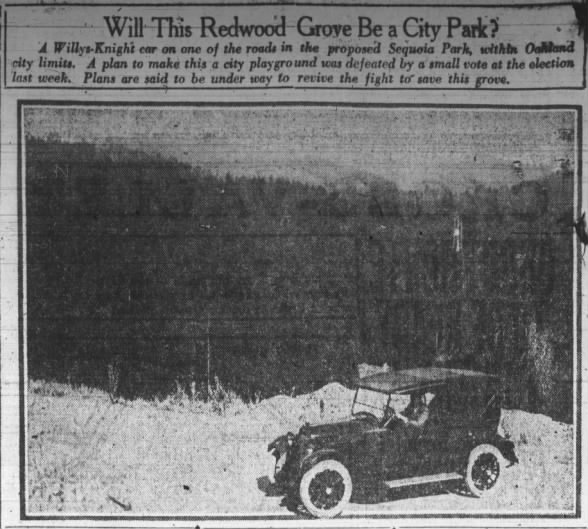 Will This Redwood Grove Be a City Park? Sun, Sep 3, 1922 – Page 2 · Oakland Tribune (Oakland, California) · Newspapers.com
Will This Redwood Grove Be a City Park? Sun, Sep 3, 1922 – Page 2 · Oakland Tribune (Oakland, California) · Newspapers.com
Will This Redwood Grove Be a City Park?
A Willys-Knight car on one of the roads in the proposed Sequoia Park, within Oakland city limits. A plan to make this a city playground was defeated by a small vote at the election last week. Plans are said to be under way to revive the fight to save this grove.
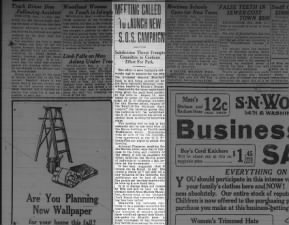 MEETING CALLED TO LAUNCH NEW S.O.S. CAMPAIGN Tue, Sep 5, 1922 – Page 11 · Oakland Tribune (Oakland, California) · Newspapers.com
MEETING CALLED TO LAUNCH NEW S.O.S. CAMPAIGN Tue, Sep 5, 1922 – Page 11 · Oakland Tribune (Oakland, California) · Newspapers.com
Inspired by the large majority of votes given the park bond project at the polls on August 29, and urged to action by the announcement of M. C. Chapman, attorney for the Havens estate, owners of the "heart of the Mountain Park project," the redwood groves that the redwoods will be subdivided, the S. O. S. committee has called a special mass meeting for tomorrow night.
The meeting will be held in the assembly hall on the third floor of the Bacon building, at Twelfth and Washington street. Representatives of each of the 145 organizations represented in the "S. O. S." committee are urged to attend the meeting.
Attorney Chapman, speaking for the Havens estate, says that in fairness to the heirs and creditors of the estate, it will be necessary to either subdivide the Havens grove of redwoods or to assure a fair return on the investment.
It has been suggested that if means can be found to pay the estate a return of 7 per cent on a fair valuation of the redwoods, the subdivision can be held off until the people get another opportunity to vote on a new bond issue.
It is to discuss ways and means to this end and to hear an important report from Marston Campbell, former head of the Oakland Park Board, that tomorrow's meeting has been called.
Meanwhile the redwoods continue to be a popular rendezvous for Eastbay folks. Saturday and Sunday hundreds of campers pitched their tents and spread their blankets under the friendly trees. A large contingent of San Francisco Boy Scouts were among the visitors.
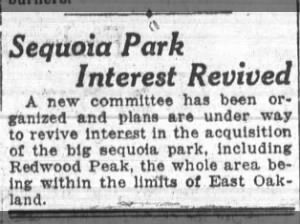 Sequoia Park Interest Revived Thu, Oct 12, 1922 – Page 10 · Oakland Tribune (Oakland, California) · Newspapers.com
Sequoia Park Interest Revived Thu, Oct 12, 1922 – Page 10 · Oakland Tribune (Oakland, California) · Newspapers.com
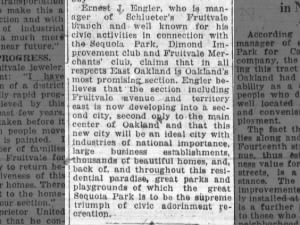 Ernest J. Engler on Fruitvale, Sequoia Park Thu, Nov 2, 1922 – Page 23 · Oakland Tribune (Oakland, California) · Newspapers.com
Ernest J. Engler on Fruitvale, Sequoia Park Thu, Nov 2, 1922 – Page 23 · Oakland Tribune (Oakland, California) · Newspapers.com
Ernest J. Engler, who is manager of Schlueter's Fruitvale branch and well known for his civic activities in connection with the Sequoia Park, Dimond Improvement club and Fruitvale Merchants' club, claims that in all respects East Oakland is Oakland's most promising section. Engler believes that the section including Fruitvale avenue and territory east is now developing into a second city, second only to the main center of Oakland and that this new city will be an ideal city with industries of national importance, large business establishments, thousands of beautiful homes, and, back of, and throughout this residential paradise, great parks and playgrounds of which the great Sequoia Park is to be the supreme triumph of civic adornment recreation.
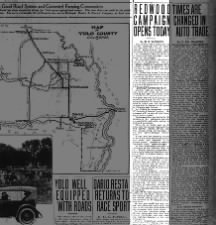 REDWOOD CAMPAIGN OPENS TODAY Sun, Feb 11, 1923 – Page 59 · Oakland Tribune (Oakland, California) · Newspapers.com
REDWOOD CAMPAIGN OPENS TODAY Sun, Feb 11, 1923 – Page 59 · Oakland Tribune (Oakland, California) · Newspapers.com
Dr. Rudolph Coffee, chairman of the S. O. S. committee has arranged a program for the occasion.
Every citizen of Oakland is interested in this program to start the ball rolling to save Oakland's redwoods.
Dr. Coffee has chosen Lincoln as the theme for his talk on why the citizens of Oakland should secure the redwoods as a municipal park, a perpetual reminder of the grandeur of the vanishing sequoias and a picnic and playground for generations to come.
Lincoln was an outdoor man. His early life when he stood defending the right of all men, white or black, to be entitled to a vote in this great republic and stamped out slavery once and for all, was an exemplification of those great lessons in truth and the bigness of things that he learned in the woods of Virginia and Illinois.
Dr. Coffee is recognized as one of Oakland's leading orators. His message will be one of vital interest to every citizen.
Today's outdoor gathering in the shadow of the redwoods provides an especially enjoyable outing for Oakland motorists.
There is no fairer spot in the hills that rise around Oakland than this natural theater off the road that swings along the shoulder of the hills above Joaquin Miller's home.
A sign over the roadway leading to the auto camp and amphitheater will direct the motorist to the proper place. "Oakland's Sequoia Mountain Park," reads the sign. At their Wednesday luncheon the members of the Oakland Real Estate Board, staunch supporters of more park lands for Oakland, voted as a body to attend today's ceremonies.
Then there are the Daughters of '61, a group of gallant women, whose days go back to those of Lincoln, every one of whom believes Oakland should secure the last of the redwoods as a park and natural playground.
A definite program, embracing the number of acres to be included in the proposed mountain park, is now being worked out by a volunteer committee of citizens, headed by Dr. Coffee and embracing representatives of civic clubs, the chamber of commerce, the real estate board, the various luncheon clubs, organized labor and other organizations.
Get the car out tomorrow, folks, and drive out Park Boulevard to the Joaquin Miller road, past the late Sierra bard's home direct to the entrance to the Sequoia Mountain Park.
Or you may drive out 35th avenue and Redwood road and then turn to the left and drop down into the proposed park from above. [See this map to imagine what the author is talking about. - MF]
Or you may continue along the Skyline boulevard from the junction of the Snake road and reach the highway leading to the redwood grove.
If you haven't an automobile, climb into the hiking togs and walk to the amphitheater.
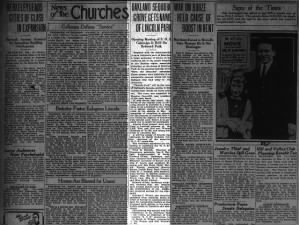 OAKLAND SEQUOIA GROVE GETS NAME OF LINCOLN PARK Mon, Feb 12, 1923 – Page 6 · Oakland Tribune (Oakland, California) · Newspapers.com
OAKLAND SEQUOIA GROVE GETS NAME OF LINCOLN PARK Mon, Feb 12, 1923 – Page 6 · Oakland Tribune (Oakland, California) · Newspapers.com
"Lincoln Park" will be the name of Oakland's Sequoia groves, it was unanimously decided by those present. The name was suggested by Marston Campbell, past president of the park board.
It was decided that about two-thirds of the original area of 1547 acres should be included in a bond issue to be submitted to the voters at a special election to be held prior to the election in May. A campaign of education is planned for the purpose of making clear to the voters the urgency of acquiring this natural park before it is parceled out to small lot-purchasers.
Among those present were more than a hundred veterans of the Civil War, and Girl and Women Workers of '61-'65, and others who lived in Lincoln's day.
A stirring eulogy of Lincoln was delivered by Rabbi Rudolph Coffee, chairman of the executive "S. O. S." committee.
The chairman appointed the following to constitute the "S. O. S." campaign committee:
Fred E. Kerrick, Chamber of Commerce, secretary; Lee S. Kerfoot, Superintendent of Parks; Howard Gilkey, landscape engineer, Oakland Park Board; Howard Schaefer, secretary of Rotary club; Abe P. Leach, past president Kiwanis, and Boy Scout Chief; Harold French, executive director Mount Diablo State Park Council; Chas. H. J. Truman, civic improvement worker; B. Marvin, American Legion; Mrs. Ed Ketchum, Mrs. Frank Law, Mrs. S. J. Newman, and Miss Birdie Pilcher.
Howard Gilkey, landscape architect, declared that the Sequoia park project should have the serious consideration of the people, and predicted success for the campaign.
Charles C. Wilson, city planning authority from Alameda, spoke in favor of having an accommodation park for automobile tourists at the proposed park, similar to the automobile parks at Yosemite and elsewhere.
The meeting was opened with the presentation of an American flag to Dr. Coffee, as chairman of the executive "S. O. S." committee, by Mrs. Sarah H. Wilson, commander of the Women and Girl Workers of '61.
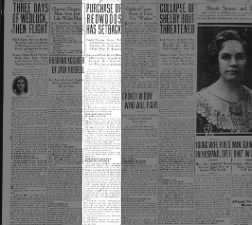 PURCHASE OF REDWOODS HAS SETBACK Fri, Jun 15, 1923 – Page 1 · Oakland Tribune (Oakland, California) · Newspapers.com
PURCHASE OF REDWOODS HAS SETBACK Fri, Jun 15, 1923 – Page 1 · Oakland Tribune (Oakland, California) · Newspapers.com
The attorneys asserted that, even if the city enters condemnation proceedings, and wins, the attorneys will insist that the judgment be satisfied within thirty days after the court decision. Otherwise they will ask that the decision be set aside.
Mayor Davie admitted today that the blow may be fatal to the city's purchase of the redwoods.
Nature-lovers and members of the park board, who have been waging the "Save Our Sequoias'' campaign for years, admit they are stunned by the latest news.
"We were just assured of our redwood grove," said President Edgar M. Sanborn of the park board. "Now we're knocked over."
All the city officials admit they "do not know just what to do about it."
Wickham Havens, representing the estate, said that "no further delay in the sale of the land is possible because of the insistence of creditors," and said the "estate is too involved to allow a long-term payment plan."
The whole matter was referred to the mayor.
President Sanborn of the park board says he has not entirely given up hope.
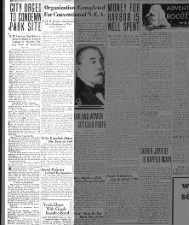 CITY URGED TO CONDEMN PARK SITE Sat, Jun 16, 1923 – Page 13 · Oakland Tribune (Oakland, California) · Newspapers.com
CITY URGED TO CONDEMN PARK SITE Sat, Jun 16, 1923 – Page 13 · Oakland Tribune (Oakland, California) · Newspapers.com
The council recently adopted a resolution to buy the mountain redwood tract for the city, by means of a three-year payment plan. Attorneys for the Havens estate yesterday informed the city council that they could not consider any three-year wait, and Wickham Havens told the council that the estate of the late Frank C. Havens is so involved that no further delay can be tolerated.
Sanborn pleaded with the mayor today that the city exercise the right of eminent domain. Sanborn says that the park board and the commercial organizations interested have never considered any three-year plan, but asked the direct purchase of the land by condemnation. Sanborn says the three-year plan was evolved by the commissioners themselves.
"May I not again respectfully call your attention to Resolution No. 2929, passed by the Board of Park Directors at a special meeting held on June 4, 1923, a copy of which is herewith enclosed.
"You will note that this resolution recommends that the Council of the City of Oakland exercise the right of eminent domain and immediately instruct the city attorney to proceed to condemn this land and provide the necessary funds for the expenses and payment of the judgment of the court in such proceedings.
At no time was a plan of payment in three annual installments considered or implied, but this method was evolved as a later consideration during discussion among the commissioners.
"You will see, therefore, that it is not necessary to obtain more specific indorsement of the plan to immediately condemn and provide the necessary funds therefor.
Public sentiment as voiced throughout the city during the last two weeks through the organizations cited and the press has been insistent that the grove of redwoods be preserved by exercising the city's right of eminent domain."
"Resolved: That the Board of Directors of the Oakland Chamber of Commerce urge upon the mayor and the commissioners of the City of Oakland the necessity of taking such steps as will assist the Board of Park Directors to acquire the contemplated Sequoia Park.
"OAKLAND CHAMBER OF COMMERCE.
"Harrison S. Robinson, President."
[I'd just like to pause and point out that Sanborn Drive is the entrance to Joaquin Miller Park. and across the street is Robinson Drive. The neighborhood was laid out in the early 1920s, and was developed by the Realty Syndicate, AKA Wickham Havens, et al. - MF]
Mayor Davie asserts, however, that the direct purchase of the parks by the city, in one gulp, is almost impossible from a financial standpoint.
"The price will amount to 10 cents on the $100 valuation in the tax rate," says Mayor Davie. "This amount, in addition to the other projects which tend to raise taxes, such as the firemen's raise and the estuary bonds and other things, would tend to break the taxpayer's back. I am for the redwoods. It would be a crying shame that Oakland should lose this beautiful grove. But can the city raise money to swallow the whole big purchase at one gulp? I have my doubts."
With kindest personal regards, believe me,
Sincerely your friend.
RUDOLPH I. COFFEE.
[This next clipping is from a much larger, full-page piece titled "MAYOR URGES BIG 1924 DEVELOPMENT PROGRAM," where Mayor John L. Davie outlines his expansion plans for the city of Oakland. It's interesting reading, and provides a lot of context for the history of Oakland, and areas that relate to the subject of this blog post. - MF]
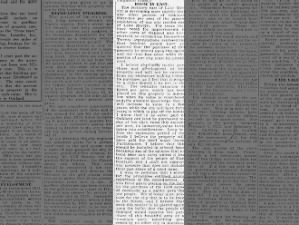 BOOM IN EAST. Tue, Jan 15, 1924 – Page 15 · Oakland Tribune (Oakland, California) · Newspapers.com
BOOM IN EAST. Tue, Jan 15, 1924 – Page 15 · Oakland Tribune (Oakland, California) · Newspapers.com
The territory east of Lake Merritt is developing more rapidly than any other portion of Oakland. Sixty-five per cent of the present population of our city resides east of Lake Merritt. For years they have voted for improvements in other parts of Oakland and have received no recognition themselves. Twenty organizations representing East Oakland people have requested that the purchase of this property be placed upon the ballot, and the time has come when this portion of our city must be considered.
I believe absolutely in the purchase and development of this property and will not be swerved from my endeavors looking toward its purchase, as I feel that it would be a crime should it be lost to the city. The tentative valuation of $1000 per acre which has been placed on this property is indeed low when its value is considered. and the absolute knowledge that it will increase in value in a few years, while the city will have forty years in which to pay off the bonds. I know that in no other part of Oakland can land be purchased today at less than twice this amount per acre, its industrial, value being taken into consideration. Long before the expiration period of the bonds I believe the property will have paid for itself many times. Furthermore, I believe that this should be included in a bond Issue because I am of the opinion that no bond issue can carry unless it has the support of the people of East Oakland, and I shall not support any measure that does not include their just share of a bond issue.
I wish to reiterate that I stand for the principles outlined above regardless of the consequences. I also favor again placing on the ballot the purchase of the 1500 acres of redwoods as a public park for our people. We of today must prepare for the city that is to be here in the future, and I believe that were this matter to be placed again upon the ballot that the people of Oakland would approve the purchase of this beautiful area as a mountain park, something possessed by no other city in America.
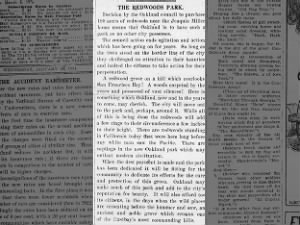 THE REDWOODS PARK. Wed, Jan 16, 1924 – Page 16 · Oakland Tribune (Oakland, California) · Newspapers.com
THE REDWOODS PARK. Wed, Jan 16, 1924 – Page 16 · Oakland Tribune (Oakland, California) · Newspapers.com
Decision by the Oakland council to purchase 180 acres of redwoods near the Joaquin Miller home means that Oakland is to have such a park as no other city possesses.
The council action ends agitation and action which has been going on for years. So long as the trees stood on the border line of the city they challenged an attention to their beauties and invited the citizens to take action for their perpetuation.
A redwood grove on a hill which overlooks San Francisco Bay! A woods carpeted by the years and possessed of vast silences! Here is something which Oakland, now and in the years to come, may cherish. The city will move out to the park and, perhaps, around it. While all of this is being done the redwoods will add a few rings to their circumference a few inches to their height. There are redwoods standing in California today that were here long before any white man saw the Pacific. There are saplings in the new Oakland park which may outlast modern civilization.
When the first payment is made and the park has been dedicated it will be fitting for the community to dedicate its efforts for the care and protection of this grove. Oakland may make much of this park and add to the city's reputation for beauty. It will also afford too its citizens, in the days when the wild places are retreating before the hammer and saw, an ancient and noble grove which crowns one of the Eastbay's most commanding hills.
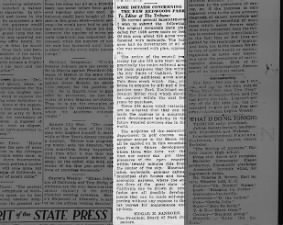 Palo Seco Creek
New Redwood Park
Sequoia Park?
Joaquin Miller Park?
Edgar M. Sanborn Wed, Jan 16, 1924 – Page 16 · Oakland Tribune (Oakland, California) · Newspapers.com
Palo Seco Creek
New Redwood Park
Sequoia Park?
Joaquin Miller Park?
Edgar M. Sanborn Wed, Jan 16, 1924 – Page 16 · Oakland Tribune (Oakland, California) · Newspapers.com
To Editor of The Tribune:
To correct several misstatements I wish to submit the following: The original mountain park plan called for 1600 acres more or less. Or this area about 250 acres were forested with redwoods. The balance had no forestation at all or else was covered with pine, cypress, etc.
The action of the council yesterday for the 180 acre tract saves practically the entire redwood area for park purposes that lies within the city limits of Oakland. There are twenty additional acres along Palo Seco creek which the city hopes to acquire by gift and a few patches near Park Boulevard and Joaquin Miller road which should be acquired within the next few years by purchase.
These 180 acres voted yesterday are so situated that they can be made the nucleus to a mountain
park development scheme in the future equaled nowhere else in the world.
The activities of the recreation department in golf courses and summer camps in the Sierra can all be carried on in this mountain park with future development where those who have not the time nor money can get these pleasures of the open country within twenty minutes ride from the center of the city. Mountain lakes, waterfalls, summer cabins, municipal club houses and inns, zoological gardens, where the entire flora of the great state of California can be grown in profusion are all possible developments that can be made self-supporting without any expense to the tax payers for maintenance and up-keep.
 Tribune Thanked For Redwood Help Fri, Jan 18, 1924 – Page 7 · Oakland Tribune (Oakland, California) · Newspapers.com
Tribune Thanked For Redwood Help Fri, Jan 18, 1924 – Page 7 · Oakland Tribune (Oakland, California) · Newspapers.com
"We wish to make public acknowledgement of our gratitude to all who heard our 'voice crying out in the wilderness' for its preservation. Four years ago, we began this agitation because, as nature-loving hikers, we knew more intimately the charms of this wonderful recreation ground and scenic showplace of Oakland. We shall continue to work for its extension as far as may be found practicable our Redwood Peak and its approaches.
"And we herewith express our thanks to the Mayor and City Council for granting this boon and our appreciation of the untiring efforts of Park Commissioners Edgar M. Sanborn and Marston Campbell and the championship of this crusade by Rabbi Rudolph I. Coffee and all associated in the 'Save Oakland's Sequoias' Committee.
“Respectfully,
"GEORGE H. GIHON, president."
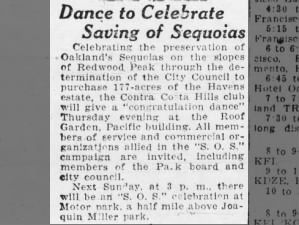 Dance to Celebrate Saving of Sequoias Mon, Jan 21, 1924 – Page 3 · Oakland Tribune (Oakland, California) · Newspapers.com
Dance to Celebrate Saving of Sequoias Mon, Jan 21, 1924 – Page 3 · Oakland Tribune (Oakland, California) · Newspapers.com
Celebrating the preservation of Oakland's Sequoias on the slopes of Redwood Peak through the determination of the City Council to purchase 177-acres of the Havens estate, the Contra Costa Hills club will give a "congratulation dance" Thursday evening at the Roof Garden, Pacific building. All members of service and commercial organizations allied in the "S. O. S." campaign are invited, including members of the Pak board and city council.
Next Sunday. at 3 p. m., there will be an "S. O. S." celebration at Motor park, a half mile above Joaquin Miller park.
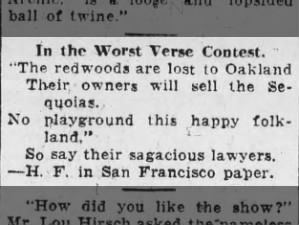 In the Worst Verse Contest Thu, Jan 31, 1924 – Page 16 · Oakland Tribune (Oakland, California) · Newspapers.com
In the Worst Verse Contest Thu, Jan 31, 1924 – Page 16 · Oakland Tribune (Oakland, California) · Newspapers.com
"The redwoods are lost to Oakland
Their owners will sell the Sequoias.
No playground this happy folkland,"
So say their sagacious lawyers.
- H. F. in San Francisco paper.
[I'd bet money H. F. is Harold French, of the Contra Costa Hills Club. - MF]
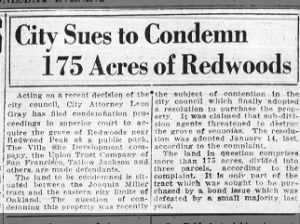 City Sues to Condemn 175 Acres of Redwoods Wed, Feb 20, 1924 – Page 19 · Oakland Tribune (Oakland, California) · Newspapers.com
City Sues to Condemn 175 Acres of Redwoods Wed, Feb 20, 1924 – Page 19 · Oakland Tribune (Oakland, California) · Newspapers.com
The land to be condemned is situated between the Joaquin Miller tract and the eastern city limits of Oakland. The question of condemning this property was recently the subject of contention in the city council which finally adopted a resolution to purchase the property. It was claimed that sub-division agents threatened to destroy the grove of sequoias. The resolution was adopted January 14, last, according to the complaint.
The land in question comprises more than 175 acres, divided into three parcels, according to the complaint. It is only part of the tract which was sought to be purchased by a bond issue which was defeated by a small majority last year.
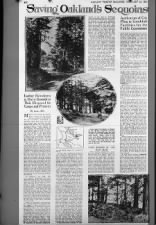 Saving Oakland's Sequoia's by Louis Allen Sun, Feb 24, 1924 – Page 72 · Oakland Tribune (Oakland, California) · Newspapers.com
Saving Oakland's Sequoia's by Louis Allen Sun, Feb 24, 1924 – Page 72 · Oakland Tribune (Oakland, California) · Newspapers.com
MUCH of the charm of the Sequoia groves of the Sierra will be available to Oaklanders for recreation, picnicking or summer camp sites, now that the city council has decided to purchase 180 acres of the Havens redwood grove on the slopes of Redwood Peak. But instead of the journey of hundreds of miles to the Sierra groves, Oakland residents will be able to hike or motor the three miles to the park from the end of the Park Boulevard street car line. When court proceedings have established the price to be paid for the acreage, Oakland will become the only city in the world boasting a park of redwoods within its city limits.
The only other redwood grove that may be said to be near a large city is Muir Woods, ten miles north of San Francisco in Marin county, and separated from the city by the Golden Gate and a stretch of hilly country. Oakland's redwood park will be less than four miles in an air line from the city hall. Not only will the park be easy of access for the hiker, but the present Skyline boulevard extension carries the autoist into the midst of the park on the side of Redwood Peak. With the acquisition of other acreages between the redwoods and the Montclair district another road is projected to run from the city's center to the top of Redwood Peak, passing through Dimond Canyon, to Palo Seco Canyon, passing the north side of Joaquin Miller park and thence to the summit of Redwood Peak.
On January 14, 1924, the city council approved the recommendation of the board of park directors to purchase the 180-acre tract on the three-payment plan. City Attorney Leon Gray was ordered to start condemnation proceedings and to secure appraisal of the property's valuation through court action. One third of the valuation placed on the grove will be paid to the Havens estate in July, the city taking out a lease on the remaining two-thirds of the property. Next year a second payment will be made and the remaining third of the property re-leased. In the third year final payment will be made.
From a ferryboat approaching the Oakland side the proposed Sequoia park is most readily located. Directly back of Oakland the most prominent hill in the ridge is Round Top. To the north (left) of Round Top and directly back of the Campanile of the University of California is Grizzly Peak. To the south (right) of Round Top is a prominence which is easily recognized as Redwood Peak. The straight, lofty conifers stand out along the ridge of Redwood Peak like a pompadour, The grove to be acquired by Oakland is located on the south slope of Redwood Peak.
As the map indicates, Redwood park abuts on the eastern boundary of Joaquin Miller park. The park extends eastward on the north side of Joaquin Miller road for nearly a mile northward in a lop-sided square for almost three-quarters of a mile. Its northern boundary is just a hundred yards or so below the amphitheater near the summit of Redwood Peak.
With the development of Redwood park the park directors contemplate the utilization of the park area for the greatest possible public good. Although plans are not yet ripe as to establishment of golf courses in the areas contiguous to Redwood park, the directors have in mind possible future development of municipal golf courses in the vicinity. Undoubtedly one of the first actions taken with actual acquisition of the park will be preparation for establishing summer camps within the area where hundreds of Oakland people may spend their vacations. All the lure of camping under the clean, virile redwoods of California Redwood Park, or Sequoia National Park, will be the camper's without the inconvenience of great effort to reach the other famous groves. One may take his bedding on his back and hike from Oakland to a camp site under the redwoods, so close in is the park. Several lookout towers are contemplated for the use of visitors to the park. One of the finest views of the bay district will thus be made possible.
The August 29, 1922 bond measure didn't get enough votes. If it had, we might have had a 1500-acre park that stretched from Snake road to Skyline & Joaquin Miller roads:
 |
| Proposed map of Oakland Sequoia Mountain Park, from the August 10, 1922 issue of the Oakland Tribune, drawn by Howard Gilkey, city landscape engineer. See Part 1 for the article. 300 dpi version of this image here, if you want to see detail. You'll notice current street names under the northern section. (Map is rotated -45º, to represent the artwork the way it was printed.) |
The newspaper clippings below continue to tell the story of Sequoia Mountain Park. It did get built. The Havens Estate did develop some of its holdings, which the city had hoped to buy. There's a decent chance you live in one of those developments. I do. What was Sequoia (Mountain) Park is now part of Joaquin Miller Park. Here's the history.
 S. O. S. LEADERS WILL CONTINUE TO URGE PARK Thu, Aug 31, 1922 – Page 17 · Oakland Tribune (Oakland, California) · Newspapers.com
S. O. S. LEADERS WILL CONTINUE TO URGE PARK Thu, Aug 31, 1922 – Page 17 · Oakland Tribune (Oakland, California) · Newspapers.comS.O.S. LEADERS WILL CONTINUE TO URGE PARK
"The people of Oakland have spoken. They demand more parks and it is up to this committee to continue its efforts to carry out the voice of more than 25,000 electors who voted for the Sequoia Mountain Park Bond issue Tuesday."In these words, Ernest J. Engler, chairman of the Save Oakland's Sequoias Committee, spoke at a meeting of the committee in the Bacon building last night.
As Marston Campbell, past president of the Park Board and chairman of the advisory committee of the Contra Costa Hills club, put it:
"This is time for rejoicing. The victory at the polls Tuesday was so complete that it leaves no doubt as to whether the citizens of Oakland demand the purchase of Sequoia Mountain Park. They do demand more parks.
With this in mind, the "S.O.S." committee has made plans to carry on the work in which more than 145 civic, commercial organized labor, and various women's clubs, were actively identified.
That the bond issue will be resubmitted to the people at the spring election is certain if other steps to acquire the Sequoia Mountain Park are not taken in the meantime."
Meanwhile it is proposed to stage "Ersa of the Red Trees," an allegorical play carrying out the plea
"save the redwoods", in Dimond Canyon with the next few weeks, to raise funds to wipe out a campaign deficit.
"Ersa of the Red Trees", is produced by the Mountain, Forest and Desert Players, directed by Garnet Holme, co-author of the play. It was recently produced to a great audience in the Big Basin and later at the Grant National Park.
 Will This Redwood Grove Be a City Park? Sun, Sep 3, 1922 – Page 2 · Oakland Tribune (Oakland, California) · Newspapers.com
Will This Redwood Grove Be a City Park? Sun, Sep 3, 1922 – Page 2 · Oakland Tribune (Oakland, California) · Newspapers.comWill This Redwood Grove Be a City Park?
A Willys-Knight car on one of the roads in the proposed Sequoia Park, within Oakland city limits. A plan to make this a city playground was defeated by a small vote at the election last week. Plans are said to be under way to revive the fight to save this grove.
 MEETING CALLED TO LAUNCH NEW S.O.S. CAMPAIGN Tue, Sep 5, 1922 – Page 11 · Oakland Tribune (Oakland, California) · Newspapers.com
MEETING CALLED TO LAUNCH NEW S.O.S. CAMPAIGN Tue, Sep 5, 1922 – Page 11 · Oakland Tribune (Oakland, California) · Newspapers.comMEETING CALLED TO LAUNCH NEW S.O.S. CAMPAIGN
Subdivision Threat Prompts Committee to Continue Effort For Park.
The effort to save Oakland's redwoods and to acquire for the city the proposed Sequoia Mountain Park is still being carried on by the Save Oakland's Sequoias committee, headed by Ernest J. Engler.Inspired by the large majority of votes given the park bond project at the polls on August 29, and urged to action by the announcement of M. C. Chapman, attorney for the Havens estate, owners of the "heart of the Mountain Park project," the redwood groves that the redwoods will be subdivided, the S. O. S. committee has called a special mass meeting for tomorrow night.
The meeting will be held in the assembly hall on the third floor of the Bacon building, at Twelfth and Washington street. Representatives of each of the 145 organizations represented in the "S. O. S." committee are urged to attend the meeting.
Attorney Chapman, speaking for the Havens estate, says that in fairness to the heirs and creditors of the estate, it will be necessary to either subdivide the Havens grove of redwoods or to assure a fair return on the investment.
It has been suggested that if means can be found to pay the estate a return of 7 per cent on a fair valuation of the redwoods, the subdivision can be held off until the people get another opportunity to vote on a new bond issue.
It is to discuss ways and means to this end and to hear an important report from Marston Campbell, former head of the Oakland Park Board, that tomorrow's meeting has been called.
Meanwhile the redwoods continue to be a popular rendezvous for Eastbay folks. Saturday and Sunday hundreds of campers pitched their tents and spread their blankets under the friendly trees. A large contingent of San Francisco Boy Scouts were among the visitors.
 Sequoia Park Interest Revived Thu, Oct 12, 1922 – Page 10 · Oakland Tribune (Oakland, California) · Newspapers.com
Sequoia Park Interest Revived Thu, Oct 12, 1922 – Page 10 · Oakland Tribune (Oakland, California) · Newspapers.comSequoia Park Interest Revived
A new committee has been organized and plans are under way to revive interest in the acquisition of the big sequoia park, including Redwood Peak, the whole area being within the limits of East Oakland. Ernest J. Engler on Fruitvale, Sequoia Park Thu, Nov 2, 1922 – Page 23 · Oakland Tribune (Oakland, California) · Newspapers.com
Ernest J. Engler on Fruitvale, Sequoia Park Thu, Nov 2, 1922 – Page 23 · Oakland Tribune (Oakland, California) · Newspapers.comErnest J. Engler, who is manager of Schlueter's Fruitvale branch and well known for his civic activities in connection with the Sequoia Park, Dimond Improvement club and Fruitvale Merchants' club, claims that in all respects East Oakland is Oakland's most promising section. Engler believes that the section including Fruitvale avenue and territory east is now developing into a second city, second only to the main center of Oakland and that this new city will be an ideal city with industries of national importance, large business establishments, thousands of beautiful homes, and, back of, and throughout this residential paradise, great parks and playgrounds of which the great Sequoia Park is to be the supreme triumph of civic adornment recreation.
 REDWOOD CAMPAIGN OPENS TODAY Sun, Feb 11, 1923 – Page 59 · Oakland Tribune (Oakland, California) · Newspapers.com
REDWOOD CAMPAIGN OPENS TODAY Sun, Feb 11, 1923 – Page 59 · Oakland Tribune (Oakland, California) · Newspapers.comREDWOOD CAMPAIGN OPENS TODAY
By B. S. SANDERS.
The second "Save Oakland's Sequoias" campaign will be opened this afternoon at 3 o'clock in the natural amphitheater just above the home of the late Joaquin Miller,Dr. Rudolph Coffee, chairman of the S. O. S. committee has arranged a program for the occasion.
Every citizen of Oakland is interested in this program to start the ball rolling to save Oakland's redwoods.
Dr. Coffee has chosen Lincoln as the theme for his talk on why the citizens of Oakland should secure the redwoods as a municipal park, a perpetual reminder of the grandeur of the vanishing sequoias and a picnic and playground for generations to come.
LINCOLN OUTDOOR MAN.
Lincoln was an outdoor man. His early life when he stood defending the right of all men, white or black, to be entitled to a vote in this great republic and stamped out slavery once and for all, was an exemplification of those great lessons in truth and the bigness of things that he learned in the woods of Virginia and Illinois.
Dr. Coffee is recognized as one of Oakland's leading orators. His message will be one of vital interest to every citizen.
Today's outdoor gathering in the shadow of the redwoods provides an especially enjoyable outing for Oakland motorists.
There is no fairer spot in the hills that rise around Oakland than this natural theater off the road that swings along the shoulder of the hills above Joaquin Miller's home.
A sign over the roadway leading to the auto camp and amphitheater will direct the motorist to the proper place. "Oakland's Sequoia Mountain Park," reads the sign. At their Wednesday luncheon the members of the Oakland Real Estate Board, staunch supporters of more park lands for Oakland, voted as a body to attend today's ceremonies.
Then there are the Daughters of '61, a group of gallant women, whose days go back to those of Lincoln, every one of whom believes Oakland should secure the last of the redwoods as a park and natural playground.
A definite program, embracing the number of acres to be included in the proposed mountain park, is now being worked out by a volunteer committee of citizens, headed by Dr. Coffee and embracing representatives of civic clubs, the chamber of commerce, the real estate board, the various luncheon clubs, organized labor and other organizations.
Get the car out tomorrow, folks, and drive out Park Boulevard to the Joaquin Miller road, past the late Sierra bard's home direct to the entrance to the Sequoia Mountain Park.
Or you may drive out 35th avenue and Redwood road and then turn to the left and drop down into the proposed park from above. [See this map to imagine what the author is talking about. - MF]
Or you may continue along the Skyline boulevard from the junction of the Snake road and reach the highway leading to the redwood grove.
If you haven't an automobile, climb into the hiking togs and walk to the amphitheater.
 OAKLAND SEQUOIA GROVE GETS NAME OF LINCOLN PARK Mon, Feb 12, 1923 – Page 6 · Oakland Tribune (Oakland, California) · Newspapers.com
OAKLAND SEQUOIA GROVE GETS NAME OF LINCOLN PARK Mon, Feb 12, 1923 – Page 6 · Oakland Tribune (Oakland, California) · Newspapers.comOAKLAND SEQUOIA GROVE GETS NAME OF LINCOLN PARK
Opening Meeting of S. O. S. Campaign Is Held On Redwood Peak.
Inspired with the determination to save Oakland's park of Sequoias, a large gathering of lovers of the outdoors and of the scenic beauties of the Eastbay region, assembled yesterday on the slopes of Redwood Park in the opening meeting of the “Save the Sequolas" campaign. Those present were members of an automobile caravan which left the Oakland City Hall early in the afternoon."Lincoln Park" will be the name of Oakland's Sequoia groves, it was unanimously decided by those present. The name was suggested by Marston Campbell, past president of the park board.
It was decided that about two-thirds of the original area of 1547 acres should be included in a bond issue to be submitted to the voters at a special election to be held prior to the election in May. A campaign of education is planned for the purpose of making clear to the voters the urgency of acquiring this natural park before it is parceled out to small lot-purchasers.
Among those present were more than a hundred veterans of the Civil War, and Girl and Women Workers of '61-'65, and others who lived in Lincoln's day.
A stirring eulogy of Lincoln was delivered by Rabbi Rudolph Coffee, chairman of the executive "S. O. S." committee.
The chairman appointed the following to constitute the "S. O. S." campaign committee:
Fred E. Kerrick, Chamber of Commerce, secretary; Lee S. Kerfoot, Superintendent of Parks; Howard Gilkey, landscape engineer, Oakland Park Board; Howard Schaefer, secretary of Rotary club; Abe P. Leach, past president Kiwanis, and Boy Scout Chief; Harold French, executive director Mount Diablo State Park Council; Chas. H. J. Truman, civic improvement worker; B. Marvin, American Legion; Mrs. Ed Ketchum, Mrs. Frank Law, Mrs. S. J. Newman, and Miss Birdie Pilcher.
Howard Gilkey, landscape architect, declared that the Sequoia park project should have the serious consideration of the people, and predicted success for the campaign.
Charles C. Wilson, city planning authority from Alameda, spoke in favor of having an accommodation park for automobile tourists at the proposed park, similar to the automobile parks at Yosemite and elsewhere.
The meeting was opened with the presentation of an American flag to Dr. Coffee, as chairman of the executive "S. O. S." committee, by Mrs. Sarah H. Wilson, commander of the Women and Girl Workers of '61.
 PURCHASE OF REDWOODS HAS SETBACK Fri, Jun 15, 1923 – Page 1 · Oakland Tribune (Oakland, California) · Newspapers.com
PURCHASE OF REDWOODS HAS SETBACK Fri, Jun 15, 1923 – Page 1 · Oakland Tribune (Oakland, California) · Newspapers.com
PURCHASE OF REDWOODS HAS SETBACK
Estate Owning Grove Will Not Sell Acreage to City on Anything But Cash Deal; 3-Year Plan Is Rejected
Mavor and Park Board Make Effort to Get Around the Decision; Hope Held Out for Way Out of Dilemma
The project for the city's acquisition of the Havens redwood grove by means of a three-year purchase plan was given a setback today when attorneys representing the estate of the late Frank C. Havens advised the city officials they could not consider any three-year plan, but must have cash or allow the Havens estate to sell elsewhere.The attorneys asserted that, even if the city enters condemnation proceedings, and wins, the attorneys will insist that the judgment be satisfied within thirty days after the court decision. Otherwise they will ask that the decision be set aside.
Mayor Davie admitted today that the blow may be fatal to the city's purchase of the redwoods.
MAYOR FEARS GROVE IS LOST TO CITY.
"They have us in a door," said Mayor Davie. "We can't add ten cents to the general tax levy in one year to purchase this park. It's too big an amount. It looks as if that beautiful grove is very likely to be lost to the city for all time."Nature-lovers and members of the park board, who have been waging the "Save Our Sequoias'' campaign for years, admit they are stunned by the latest news.
"We were just assured of our redwood grove," said President Edgar M. Sanborn of the park board. "Now we're knocked over."
All the city officials admit they "do not know just what to do about it."
ASSESSMENT DISTRICT MIGHT BE FEASIBLE.
City Attorney Leon E. Gray advised the council that Attorneys Charles Beardsley and E. E. Trefethen, representing the Havens interests, said they could not accept the three-year payment plan. Gray pointed out the strength of Havens' position and said that the only other way to acquire the land is by the Park and Playground Act of 1909, through which an ordinance can create an assessment district to pay for the land and, if the assessment district does not protest it out, the land can be condemned. This, however, said Gray, lays the whole burden on the assessment district.Wickham Havens, representing the estate, said that "no further delay in the sale of the land is possible because of the insistence of creditors," and said the "estate is too involved to allow a long-term payment plan."
The whole matter was referred to the mayor.
President Sanborn of the park board says he has not entirely given up hope.
 CITY URGED TO CONDEMN PARK SITE Sat, Jun 16, 1923 – Page 13 · Oakland Tribune (Oakland, California) · Newspapers.com
CITY URGED TO CONDEMN PARK SITE Sat, Jun 16, 1923 – Page 13 · Oakland Tribune (Oakland, California) · Newspapers.comCITY URGED TO CONDEMN PARK SITE
E. M. Sanborn Asks Mayor to Exercise Right of Eminent Domain to Procure Havens Tract of Redwoods
Undeterred by yesterday's setback concerning the city's acquisition of the redwoods tract for a park, President Edgar M. Sanborn of the park department today sent a letter to Mayor Davie asking condemnation of the property in question, irrespective of the wrangle over the three-year payment plan.The council recently adopted a resolution to buy the mountain redwood tract for the city, by means of a three-year payment plan. Attorneys for the Havens estate yesterday informed the city council that they could not consider any three-year wait, and Wickham Havens told the council that the estate of the late Frank C. Havens is so involved that no further delay can be tolerated.
Sanborn pleaded with the mayor today that the city exercise the right of eminent domain. Sanborn says that the park board and the commercial organizations interested have never considered any three-year plan, but asked the direct purchase of the land by condemnation. Sanborn says the three-year plan was evolved by the commissioners themselves.
PEOPLE WANT PARKS.
"The people want the parks," urges Sanborn, whose letter to the mayor follows:"May I not again respectfully call your attention to Resolution No. 2929, passed by the Board of Park Directors at a special meeting held on June 4, 1923, a copy of which is herewith enclosed.
"You will note that this resolution recommends that the Council of the City of Oakland exercise the right of eminent domain and immediately instruct the city attorney to proceed to condemn this land and provide the necessary funds for the expenses and payment of the judgment of the court in such proceedings.
PLANS INDORSED.
"This recommendation and policy of the Park Board as to method of acquiring the redwoods has been unanimously indorsed by the leading commercial, service, labor and improvement organizations of our city, typical of which is the enclosed resolution of the Chamber of Commerce.At no time was a plan of payment in three annual installments considered or implied, but this method was evolved as a later consideration during discussion among the commissioners.
"You will see, therefore, that it is not necessary to obtain more specific indorsement of the plan to immediately condemn and provide the necessary funds therefor.
Public sentiment as voiced throughout the city during the last two weeks through the organizations cited and the press has been insistent that the grove of redwoods be preserved by exercising the city's right of eminent domain."
C. OF C. FOR PARK
Sanborn's contention is borne out by the recent Chamber of Commerce resolution for the purchase of the redwoods, which says:"Resolved: That the Board of Directors of the Oakland Chamber of Commerce urge upon the mayor and the commissioners of the City of Oakland the necessity of taking such steps as will assist the Board of Park Directors to acquire the contemplated Sequoia Park.
"OAKLAND CHAMBER OF COMMERCE.
"Harrison S. Robinson, President."
[I'd just like to pause and point out that Sanborn Drive is the entrance to Joaquin Miller Park. and across the street is Robinson Drive. The neighborhood was laid out in the early 1920s, and was developed by the Realty Syndicate, AKA Wickham Havens, et al. - MF]
Mayor Davie asserts, however, that the direct purchase of the parks by the city, in one gulp, is almost impossible from a financial standpoint.
"The price will amount to 10 cents on the $100 valuation in the tax rate," says Mayor Davie. "This amount, in addition to the other projects which tend to raise taxes, such as the firemen's raise and the estuary bonds and other things, would tend to break the taxpayer's back. I am for the redwoods. It would be a crying shame that Oakland should lose this beautiful grove. But can the city raise money to swallow the whole big purchase at one gulp? I have my doubts."
Conferences on the subject began in the city hall today.
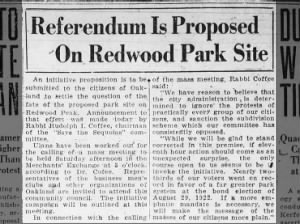 Referendum Is Proposed on Redwood Park Site Sat, Jan 5, 1924 – Page 11 · Oakland Tribune (Oakland, California) · Newspapers.com
Referendum Is Proposed on Redwood Park Site Sat, Jan 5, 1924 – Page 11 · Oakland Tribune (Oakland, California) · Newspapers.com
Plans have been worked out for the calling of a mass meeting to be held Saturday afternoon in the Merchants' Exchange at 3 o'clock, according to Dr. Coffee. Representatives of the business men's clubs and other organizations of Oakland are invited to attend this community council. The initiative campaign will be outlined at this meeting.
In connection with the calling of the mass meeting, Rabbi Coffee said:
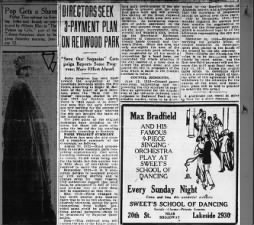 DIRECTORS SEEK 3-PAYMENT PLAN ON REDWOOD PEAK Sun, Jan 6, 1924 – Page 2 · Oakland Tribune (Oakland, California) · Newspapers.com
DIRECTORS SEEK 3-PAYMENT PLAN ON REDWOOD PEAK Sun, Jan 6, 1924 – Page 2 · Oakland Tribune (Oakland, California) · Newspapers.com
The 1500 acres of the original campaign have dwindled to 180 acres, but those 180 acres comprise the best of the big standing redwoods, according to Sanborn.
August 29, 1922 - Bond proposition to acquire mountain park comprising approximately 1500 acres, including redwood areas, submitted to voters; 25,486 votes being cast for the bonds, but this number was a little short of two-thirds' vote required to carry the proposition.
September, 1922 - S. 0. S. committee decides to resubmit project at 1923 spring election and to change areas for legal reasons. City authorities suggest that bond issue be postponed to fall of 1923 and promise that no other issue will be considered at that time.
May, 1933 - Plans changed to buy much smaller area because there was to be no fall election, exclusively redwoods, except for park connections, from budget, provided same could be acquired on three annual payments - value to be determined by Superior Court action.
Note - (This redwood area will control the key to the future mountain park development if the city desires to proceed along the original plans later and will prevent the cutting of the finest redwood grove in the whole area into subdivisions. An unanimous expression of public sentiment on the plan was secured from practically all the labor, improvement, commercial and women's club, including the Merchants' Exchange, Chamber of Commerce, Alameda County Labor Council and Car-men's Union. Since the area was only one-eighth the area of the original mountain park scheme, it was considered by all too small a proposition for a bond issue, yet controlled the whole situation it the city desired at a later date to acquire the original area; and also placed the city in possession of the area, which is liable to the greatest increase in value.)
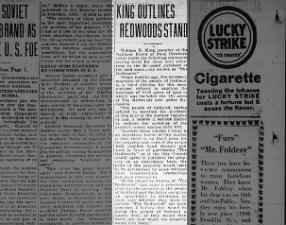 KING OUTLINES REDWOOD STAND Mon, Jan 7, 1924 – Page 2 · Oakland Tribune (Oakland, California) · Newspapers.com
KING OUTLINES REDWOOD STAND Mon, Jan 7, 1924 – Page 2 · Oakland Tribune (Oakland, California) · Newspapers.com
"Some months ago, the necessary majority of the people of Oakland, in a bond election for this same purpose, refused to sanction the purchase of 1500 acres of land in which was included the 181 acres of The Redwoods now under discussion.
"The people of Oakland, having refused to sanction the purchase of this land in the manner required by law, I believe it serious matter to endorse the spending of the people's money against their will.
"Another thing which I think is an important factor in this matter is that there is no fixed price for the property and, even if the people held another bond election and were in favor of purchasing "The Redwoods," or, if the City Council would agree to purchase the property on an installment basis, the price of the property would have to be determined by some tribunal after condemnation proceedings had been resorted to.
"If the owner or owners of "The Redwoods" can name a reasonable price for the property to the people of Oakland and the latter are given an opportunity to determine by their vote whether they want to acquire "The Redwoods" for park purposes. I believe that would be giving the people of Oakland a square deal, as they would then know just how much the property would cost them."
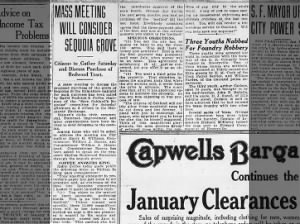 MASS MEETING WILL CONSIDER SEQUOIA GROVE Tue, Jan 8, 1924 – Page 5 · Oakland Tribune (Oakland, California) · Newspapers.com
MASS MEETING WILL CONSIDER SEQUOIA GROVE Tue, Jan 8, 1924 – Page 5 · Oakland Tribune (Oakland, California) · Newspapers.com
Women's clubs, civic, commercial, fraternal, improvement and labor organizations have been invited to send delegates to the meeting.
Among those who will be asked to address the meeting are City Auditor Harry G. Williams, Commissioner William J. Baccus, and Commissioner William J. Moorehead. Commissioner Baccus has been asked to speak on the proposed Skyline Boulevard Extension through the sequoia grove.
Rabbi Coffee today made public the following letter to William R. King, park commissioner:
"Your amazing statement in yesterday's paper has just come to my attention and, as chairman of the Save Our Sequoias committee, I hasten to make immediate reply.
"(1) You object to the method of three payments, preferring bonds. This is no time to talk 'method.' Unless council acts speedily, these 12,000 magnificent trees will be lost forever. The method we urge is the one presented to council by the mayor and unanimously passed last June by that body. That method also had the unanimous approval of the park board. Strange that during the past seven months, you had no criticism of the 'method' till the last hour. Everybody consulted agrees that the three-payment plan is the best, and now at this critical moment you object to the 'method.'
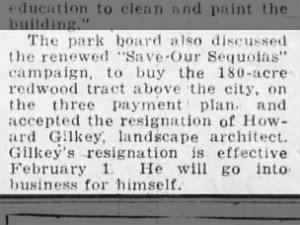 Park board discusses "Save Our Sequoias" campaign, accepts resignation of Gilkey Wed, Jan 9, 1924 – Page 14 · Oakland Tribune (Oakland, California) · Newspapers.com
Park board discusses "Save Our Sequoias" campaign, accepts resignation of Gilkey Wed, Jan 9, 1924 – Page 14 · Oakland Tribune (Oakland, California) · Newspapers.com
The park board also discussed the renewed "Save Our Sequoias" campaign, to buy the 180-acre redwood tract above the city, on the three payment plan, and accepted the resignation of Howard Gilkey, landscape architect. Gilkey's resignation is effective February 1. He will go into business for himself.
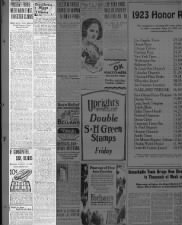 PRESENT PARKS NEED WORK FIRST, DIRECTOR CLAIMS Thu, Jan 10, 1924 – Page 13 · Oakland Tribune (Oakland, California) · Newspapers.com
PRESENT PARKS NEED WORK FIRST, DIRECTOR CLAIMS Thu, Jan 10, 1924 – Page 13 · Oakland Tribune (Oakland, California) · Newspapers.com
Following is the full statement prepared by King in answer to the statement of Dr. Coffee, which was published Tuesday:
I was rather surprised at the public statement you submitted to the press under the disguise of a personal letter to me. I never received a letter from you. Further, your personal opinion of my attitude or policy was not gained through personal touch, but evidently was a personal peeve on your part because I dared to disagree with you or those who are advocating the sale of the "Redwoods" to the people of Oakland.
"I note you stated you hastened a reply to me. I fully agree that your statement was hasty, and so will everyone who knows anything about the proposed three-payment plan for the Purchase of the "Redwoods."
In the first place, I was not a member of the park board when they passed a resolution recommending to the city council to authorize someone to try to negotiate for the purchase of the "Redwoods," and the stipulation for the purchase of the "Redwoods" was not presented to the park board until December 26, 1923, for their consideration, and on that date was the first time the matter was presented to the park directors since I have been a member, and the minutes of the park board will prove this to be a fact.
I do not know you. I never met you, and as long as I have been a member of the park directors I have never known of you to attend one of our meetings, therefore, your opinion of my attitude or policy has been obtained through hearsay.
My policy with respect to our parks is as follows, so you may have it first hand. I believe if the people of Oakland have two, or three hundred thousand dollars to spend on parks, it would be more to their advantage to spend the amount in the improvement of our present unimproved parks, and for your information, we now have about 100 acres of park property in the city of Oakland which has not been improved. We should beautify our present improved parks and establish more tennis and volley ball courts, comfort stations, and make additional improvements which would make our parks attractive and useful for the people of Oakland. But before such an expenditure is made I believe the people who pay the bills should first sanction it.
You say I am opposed to due process of law. If any process of law will deny the people of Oakland a fair deal in a matter of this kind, then you are right, as I will always protest against any law which will not give the people of Oakland a square deal.
You say all concerned are satisfied with the proposed three-payment plan which you advocate. Who do you mean by all concerned? If you mean yourself or those who are advocating the plan, then of course I will agree with you, but if you mean the people of Oakland, then I disagree with you, as they went on record once as being against the purchase of the "Redwoods."
I have no doubt that you are very anxious to have the city of Oakland buy the "Redwoods," and so are the people who own the "Redwoods," but on the other hand, are the people who have to pay for this property as anxious to buy it? That is the question before us, and the only way that question can be answered is by permitting the people by their ballot to determine whether they want the "Redwoods" or not.
There should be nothing personal between you and myself about this matter. I think the plan which you advocate is wrong, but I do not believe you should get peeved because I don't agree with you and resort to insinuations as to my ability or anything in connection therewith.
As a public official for the city of Oakland I intend to follow the policy I have followed all my life, and that is, I can look anyone in the eye and conscientiously tell him to go to the devil if he asks me to do something which I feel is wrong. You ask me to encourage the mayor who appointed me to favor the plan you advocate. I realize the mayor of our city appointed me as park director and will always be loyal to him as mayor of this city, and know him well enough to know he would never ask me to do anything which he would believe is wrong and I will not him to do anything which I think is wrong.
I hope we may at some future time meet each other and such a meeting may prove more satisfactory than letter writing,"
 SEQUOIA TRACT PURCHASE URGED Sun, Jan 13, 1924 – Page 1 · Oakland Tribune (Oakland, California) · Newspapers.com
SEQUOIA TRACT PURCHASE URGED Sun, Jan 13, 1924 – Page 1 · Oakland Tribune (Oakland, California) · Newspapers.com
The mass meeting was called by Rabbi Rudolph I. Coffee. Melvin C. Chapman, president of the Alameda County Bar association and representative of the owners of the tract, announced that, after waiting four years for action by the city "at a loss of more than $75,000," the owners of the property are now forced by their creditors to subdivide this property at once and sell it, unless the city finally accepts the option which expires Tuesday.
Marston Campbell and E. M. Sanborn, members of the Park Commission, gave their unqualified approval to the project and outlined the proposition which has been approved by the Park Commission and the council.
Norman Campbell and C. C. Young of the Chamber of Commerce, Wilber Walker of the Merchants' Exchange, and representatives of the Uptown and Downtown associations, the Business and Professional Women's clubs, the Federation of Women Voters, the Federation of Women's clubs and several of the luncheon service clubs addressed the meeting. Every speaker urged the immediate acceptance of the option now held by the city on this tract and spoke of the great loss to Oakland that would be suffered if this tract should be subdivided and not made into a public park.
 3-PAYMENT PLAN PASSED BY COUNCIL Mon, Jan 14, 1924 – Page 1 · Oakland Tribune (Oakland, California) · Newspapers.com
3-PAYMENT PLAN PASSED BY COUNCIL Mon, Jan 14, 1924 – Page 1 · Oakland Tribune (Oakland, California) · Newspapers.com
 Tribune Thanked for Redwood Fight Aid Tue, Jan 15, 1924 – Page 35 · Oakland Tribune (Oakland, California) · Newspapers.com
Tribune Thanked for Redwood Fight Aid Tue, Jan 15, 1924 – Page 35 · Oakland Tribune (Oakland, California) · Newspapers.com
 Referendum Is Proposed on Redwood Park Site Sat, Jan 5, 1924 – Page 11 · Oakland Tribune (Oakland, California) · Newspapers.com
Referendum Is Proposed on Redwood Park Site Sat, Jan 5, 1924 – Page 11 · Oakland Tribune (Oakland, California) · Newspapers.com
Referendum Is Proposed on Redwood Park Site
An initiative proposition is to be submitted to the citizens of Oakland to settle the question of the fate of the proposed park site on Redwood Peak. Announcement to that effect was made today by Rabbi Rudolph I. Coffee, chairman of the "Save the Sequoias" committee.Plans have been worked out for the calling of a mass meeting to be held Saturday afternoon in the Merchants' Exchange at 3 o'clock, according to Dr. Coffee. Representatives of the business men's clubs and other organizations of Oakland are invited to attend this community council. The initiative campaign will be outlined at this meeting.
In connection with the calling of the mass meeting, Rabbi Coffee said:
"We have reason to believe that the city administration is determined to ignore the protests of practically every group of our citizens, and sanction the subdivision scheme which our committee has consistently opposed.
"While we will be glad to stand corrected in this premise, if eleventh hour action should come as an unexpected surprise, the only course open to us seems to be invoke the initiative. Nearly two-thirds of our voters went on record in favor of a far greater park system at the bond election of August 29, 1922. If a more emphatic mandate is necessary, we will make the message of the masses of our citizens more plain."
 DIRECTORS SEEK 3-PAYMENT PLAN ON REDWOOD PEAK Sun, Jan 6, 1924 – Page 2 · Oakland Tribune (Oakland, California) · Newspapers.com
DIRECTORS SEEK 3-PAYMENT PLAN ON REDWOOD PEAK Sun, Jan 6, 1924 – Page 2 · Oakland Tribune (Oakland, California) · Newspapers.comDIRECTORS SEEK 3-PAYMENT PLAN ON REDWOOD PARK
"Save Our Sequoias” Campaign Reports Some Progress: More Effort Ahead.
Some progress has been made toward the acquisition of the mountain redwoods within the city limits, according to Edgar M. Sanborn of the board of park directors, since the "Save Our SequoIas" campaign started in August, 1922, but Sanborn asserts there is "still much to be done," and says that the park directors are now battling for the success of the "three-payment plan" whereby the city can acquire the lands on the installment idea.The 1500 acres of the original campaign have dwindled to 180 acres, but those 180 acres comprise the best of the big standing redwoods, according to Sanborn.
PARK PROJECT SUMMARY.
Sanborn has sent the city council a: complete summary of the campaign, as follows:August 29, 1922 - Bond proposition to acquire mountain park comprising approximately 1500 acres, including redwood areas, submitted to voters; 25,486 votes being cast for the bonds, but this number was a little short of two-thirds' vote required to carry the proposition.
September, 1922 - S. 0. S. committee decides to resubmit project at 1923 spring election and to change areas for legal reasons. City authorities suggest that bond issue be postponed to fall of 1923 and promise that no other issue will be considered at that time.
May, 1933 - Plans changed to buy much smaller area because there was to be no fall election, exclusively redwoods, except for park connections, from budget, provided same could be acquired on three annual payments - value to be determined by Superior Court action.
Note - (This redwood area will control the key to the future mountain park development if the city desires to proceed along the original plans later and will prevent the cutting of the finest redwood grove in the whole area into subdivisions. An unanimous expression of public sentiment on the plan was secured from practically all the labor, improvement, commercial and women's club, including the Merchants' Exchange, Chamber of Commerce, Alameda County Labor Council and Car-men's Union. Since the area was only one-eighth the area of the original mountain park scheme, it was considered by all too small a proposition for a bond issue, yet controlled the whole situation it the city desired at a later date to acquire the original area; and also placed the city in possession of the area, which is liable to the greatest increase in value.)
COUNCIL RESOLVES.
June 12, 1923 - Council passes resolution authorizing and empowering the city attorney to negotiate an agreement for the acquisition of the 180-acre redwood tract adjacent to Redwood Peak at reasonable market, value to be determined by the Superior Court of Alameda county, and arrangements that the payments of judgments should be spread over three years.
July to December, 1923 - Two months required for surveys and four months for negotiations to work out the three-payment plan, which is considered legal by all the attorneys representing the city and owners.
December 31, 1923 - Stipulation carrying out general intent of council resolution on three-payment plan placed in the hands of the council by the city attorney.
Note (Under the stipulation the value is to be determined immediately by court action, but the first one-third payment will not become due until next fiscal year, or July 15, 1924. Unless the council takes action to determine value within a reasonable length of time, the offer of this agreement will be withdrawn by the attorneys for the owners of the tract, and immediate plans will be laid to proceed to subdivide this area.)
 KING OUTLINES REDWOOD STAND Mon, Jan 7, 1924 – Page 2 · Oakland Tribune (Oakland, California) · Newspapers.com
KING OUTLINES REDWOOD STAND Mon, Jan 7, 1924 – Page 2 · Oakland Tribune (Oakland, California) · Newspapers.comKING OUTLINES REDWOODS STAND
William R. King, member of the Oakland Board of Park Directors, today made the following statement setting forth his ideas with reference to the proposed purchase of the land commonly known as "The Redwoods.""Some months ago, the necessary majority of the people of Oakland, in a bond election for this same purpose, refused to sanction the purchase of 1500 acres of land in which was included the 181 acres of The Redwoods now under discussion.
"The people of Oakland, having refused to sanction the purchase of this land in the manner required by law, I believe it serious matter to endorse the spending of the people's money against their will.
"Another thing which I think is an important factor in this matter is that there is no fixed price for the property and, even if the people held another bond election and were in favor of purchasing "The Redwoods," or, if the City Council would agree to purchase the property on an installment basis, the price of the property would have to be determined by some tribunal after condemnation proceedings had been resorted to.
"If the owner or owners of "The Redwoods" can name a reasonable price for the property to the people of Oakland and the latter are given an opportunity to determine by their vote whether they want to acquire "The Redwoods" for park purposes. I believe that would be giving the people of Oakland a square deal, as they would then know just how much the property would cost them."
 MASS MEETING WILL CONSIDER SEQUOIA GROVE Tue, Jan 8, 1924 – Page 5 · Oakland Tribune (Oakland, California) · Newspapers.com
MASS MEETING WILL CONSIDER SEQUOIA GROVE Tue, Jan 8, 1924 – Page 5 · Oakland Tribune (Oakland, California) · Newspapers.com
MASS MEETING WILL CONSIDER SEQUOIA GROVE
Citizens to Gather Saturday and Discuss Purchase of Redwood Tract.
A mass meeting to discuss the proposed purchase of the grove of Sequoias in the hills above Oakland for park purposes has been called by Rabbi Rudolph I. Coffee, chairman of the "Save Oakland's Sequoias" committee, for Saturday afternoon at 3 o'clock in the Merchants' Exchange.Women's clubs, civic, commercial, fraternal, improvement and labor organizations have been invited to send delegates to the meeting.
Among those who will be asked to address the meeting are City Auditor Harry G. Williams, Commissioner William J. Baccus, and Commissioner William J. Moorehead. Commissioner Baccus has been asked to speak on the proposed Skyline Boulevard Extension through the sequoia grove.
COFFEE ANSWERS KING.
Rabbi Coffee today made public the following letter to William R. King, park commissioner:
"Your amazing statement in yesterday's paper has just come to my attention and, as chairman of the Save Our Sequoias committee, I hasten to make immediate reply.
"(1) You object to the method of three payments, preferring bonds. This is no time to talk 'method.' Unless council acts speedily, these 12,000 magnificent trees will be lost forever. The method we urge is the one presented to council by the mayor and unanimously passed last June by that body. That method also had the unanimous approval of the park board. Strange that during the past seven months, you had no criticism of the 'method' till the last hour. Everybody consulted agrees that the three-payment plan is the best, and now at this critical moment you object to the 'method.'
SPECIOUS OBJECTIONS.
"(2) You say the city has no money on hand to pay for these 180 acres. Who said there is money now available? That is why the first payment was postponed until next July, when money will be on hand. This agreement is satisfactory to all parties concerned, yet you offer it as an objection.
"(3) You want a fixed price for the property. That objection ignores the simplest truth that when the city secures land. It never fixes the price in advance. The court does that, after it has appointed experts to appraise the property. So you are now objecting to due process of law.
"The citizens of Oakland will not idly allow these wonderful trees to be cut down and lost forever. I plead with you to encourage the mayor, who appointed you, to favor the plan that he himself suggested. Think of this magnificent playgrounds, the most glorious group of redwood trees within the confines of any city in the whole world. I beg of you to cease casting up nonsensical objectiong and childish criticism at the last moment. You still can render a tremendous service to Oakland. Will you help save our sequoias?"
 Park board discusses "Save Our Sequoias" campaign, accepts resignation of Gilkey Wed, Jan 9, 1924 – Page 14 · Oakland Tribune (Oakland, California) · Newspapers.com
Park board discusses "Save Our Sequoias" campaign, accepts resignation of Gilkey Wed, Jan 9, 1924 – Page 14 · Oakland Tribune (Oakland, California) · Newspapers.comThe park board also discussed the renewed "Save Our Sequoias" campaign, to buy the 180-acre redwood tract above the city, on the three payment plan, and accepted the resignation of Howard Gilkey, landscape architect. Gilkey's resignation is effective February 1. He will go into business for himself.
 PRESENT PARKS NEED WORK FIRST, DIRECTOR CLAIMS Thu, Jan 10, 1924 – Page 13 · Oakland Tribune (Oakland, California) · Newspapers.com
PRESENT PARKS NEED WORK FIRST, DIRECTOR CLAIMS Thu, Jan 10, 1924 – Page 13 · Oakland Tribune (Oakland, California) · Newspapers.com
PRESENT PARKS NEED WORK FIRST DIRECTOR CLAIMS
Rabbi Coffee Told Oakland Should Improve Land Already Owned.
That he, as a park director, is not interested in the purchase of park lands in the foothills until the parks within the city limits are fully developed is the answer which William R. King makes to the statements of Dr. Rudolph I. Coffee, chairman of the "Save Oakland's Sequoias" committee, that King has raised "nonsensical objections and childish criticism against the prolect.Following is the full statement prepared by King in answer to the statement of Dr. Coffee, which was published Tuesday:
I was rather surprised at the public statement you submitted to the press under the disguise of a personal letter to me. I never received a letter from you. Further, your personal opinion of my attitude or policy was not gained through personal touch, but evidently was a personal peeve on your part because I dared to disagree with you or those who are advocating the sale of the "Redwoods" to the people of Oakland.
HEARSAY CHARGED.
"I note you stated you hastened a reply to me. I fully agree that your statement was hasty, and so will everyone who knows anything about the proposed three-payment plan for the Purchase of the "Redwoods."
In the first place, I was not a member of the park board when they passed a resolution recommending to the city council to authorize someone to try to negotiate for the purchase of the "Redwoods," and the stipulation for the purchase of the "Redwoods" was not presented to the park board until December 26, 1923, for their consideration, and on that date was the first time the matter was presented to the park directors since I have been a member, and the minutes of the park board will prove this to be a fact.
I do not know you. I never met you, and as long as I have been a member of the park directors I have never known of you to attend one of our meetings, therefore, your opinion of my attitude or policy has been obtained through hearsay.
FOR SQUARE DEAL.
My policy with respect to our parks is as follows, so you may have it first hand. I believe if the people of Oakland have two, or three hundred thousand dollars to spend on parks, it would be more to their advantage to spend the amount in the improvement of our present unimproved parks, and for your information, we now have about 100 acres of park property in the city of Oakland which has not been improved. We should beautify our present improved parks and establish more tennis and volley ball courts, comfort stations, and make additional improvements which would make our parks attractive and useful for the people of Oakland. But before such an expenditure is made I believe the people who pay the bills should first sanction it.
You say I am opposed to due process of law. If any process of law will deny the people of Oakland a fair deal in a matter of this kind, then you are right, as I will always protest against any law which will not give the people of Oakland a square deal.
CITY ON RECORD.
You say all concerned are satisfied with the proposed three-payment plan which you advocate. Who do you mean by all concerned? If you mean yourself or those who are advocating the plan, then of course I will agree with you, but if you mean the people of Oakland, then I disagree with you, as they went on record once as being against the purchase of the "Redwoods."
I have no doubt that you are very anxious to have the city of Oakland buy the "Redwoods," and so are the people who own the "Redwoods," but on the other hand, are the people who have to pay for this property as anxious to buy it? That is the question before us, and the only way that question can be answered is by permitting the people by their ballot to determine whether they want the "Redwoods" or not.
INSINUATIONS RESENTED.
There should be nothing personal between you and myself about this matter. I think the plan which you advocate is wrong, but I do not believe you should get peeved because I don't agree with you and resort to insinuations as to my ability or anything in connection therewith.
As a public official for the city of Oakland I intend to follow the policy I have followed all my life, and that is, I can look anyone in the eye and conscientiously tell him to go to the devil if he asks me to do something which I feel is wrong. You ask me to encourage the mayor who appointed me to favor the plan you advocate. I realize the mayor of our city appointed me as park director and will always be loyal to him as mayor of this city, and know him well enough to know he would never ask me to do anything which he would believe is wrong and I will not him to do anything which I think is wrong.
I hope we may at some future time meet each other and such a meeting may prove more satisfactory than letter writing,"
 SEQUOIA TRACT PURCHASE URGED Sun, Jan 13, 1924 – Page 1 · Oakland Tribune (Oakland, California) · Newspapers.com
SEQUOIA TRACT PURCHASE URGED Sun, Jan 13, 1924 – Page 1 · Oakland Tribune (Oakland, California) · Newspapers.comSEQUOIA TRACT PURCHASE URGED
Civic Organizations Unanimous in Call for Council Action.
By a unanimous vote, the fifty representatives of Oakland civic organizations who attended the mass meeting in the Merchants' Exchange rooms yesterday afternoon and approved a resolution asking the city council to purchase the tract of sequoias around Redwood Peak, in accordance with plans approved and completed by the city council and the park commission last summer. The representatives also promised to speak in the churches and to enlist the membership of their organizations tomorrow and Monday to persuade them to wait on the city council at the Monday morning meeting.The mass meeting was called by Rabbi Rudolph I. Coffee. Melvin C. Chapman, president of the Alameda County Bar association and representative of the owners of the tract, announced that, after waiting four years for action by the city "at a loss of more than $75,000," the owners of the property are now forced by their creditors to subdivide this property at once and sell it, unless the city finally accepts the option which expires Tuesday.
Marston Campbell and E. M. Sanborn, members of the Park Commission, gave their unqualified approval to the project and outlined the proposition which has been approved by the Park Commission and the council.
Norman Campbell and C. C. Young of the Chamber of Commerce, Wilber Walker of the Merchants' Exchange, and representatives of the Uptown and Downtown associations, the Business and Professional Women's clubs, the Federation of Women Voters, the Federation of Women's clubs and several of the luncheon service clubs addressed the meeting. Every speaker urged the immediate acceptance of the option now held by the city on this tract and spoke of the great loss to Oakland that would be suffered if this tract should be subdivided and not made into a public park.
 3-PAYMENT PLAN PASSED BY COUNCIL Mon, Jan 14, 1924 – Page 1 · Oakland Tribune (Oakland, California) · Newspapers.com
3-PAYMENT PLAN PASSED BY COUNCIL Mon, Jan 14, 1924 – Page 1 · Oakland Tribune (Oakland, California) · Newspapers.com
3-PAYMENT PLAN PASSEN BY COUNCIL
The city council, in the presence of 250 citizens interested in the "Save Our Sequolas" campaign, this morning voted that the interest of the city demanded that the city attorney be instructed to prepare condemnation proceedings for the purchase of the 180-acre redwood tract in the foothills behind the city, on the three-payment plan. Tribune Thanked for Redwood Fight Aid Tue, Jan 15, 1924 – Page 35 · Oakland Tribune (Oakland, California) · Newspapers.com
Tribune Thanked for Redwood Fight Aid Tue, Jan 15, 1924 – Page 35 · Oakland Tribune (Oakland, California) · Newspapers.com
Tribune Thanked for Redwood Fight Aid
The city council has unanimously voted to purchase the redwood forest on the three-payment plan. May I thank you for the fine support which your powerful newspaper has so consistently given our committee which has labored in and out of season to secure this wonderful grove of trees. Without your backing and the other newspapers, I hardly see how we ever could have won.With kindest personal regards, believe me,
Sincerely your friend.
RUDOLPH I. COFFEE.
[This next clipping is from a much larger, full-page piece titled "MAYOR URGES BIG 1924 DEVELOPMENT PROGRAM," where Mayor John L. Davie outlines his expansion plans for the city of Oakland. It's interesting reading, and provides a lot of context for the history of Oakland, and areas that relate to the subject of this blog post. - MF]
 BOOM IN EAST. Tue, Jan 15, 1924 – Page 15 · Oakland Tribune (Oakland, California) · Newspapers.com
BOOM IN EAST. Tue, Jan 15, 1924 – Page 15 · Oakland Tribune (Oakland, California) · Newspapers.comBOOM IN EAST.
The territory east of Lake Merritt is developing more rapidly than any other portion of Oakland. Sixty-five per cent of the present population of our city resides east of Lake Merritt. For years they have voted for improvements in other parts of Oakland and have received no recognition themselves. Twenty organizations representing East Oakland people have requested that the purchase of this property be placed upon the ballot, and the time has come when this portion of our city must be considered.
I believe absolutely in the purchase and development of this property and will not be swerved from my endeavors looking toward its purchase, as I feel that it would be a crime should it be lost to the city. The tentative valuation of $1000 per acre which has been placed on this property is indeed low when its value is considered. and the absolute knowledge that it will increase in value in a few years, while the city will have forty years in which to pay off the bonds. I know that in no other part of Oakland can land be purchased today at less than twice this amount per acre, its industrial, value being taken into consideration. Long before the expiration period of the bonds I believe the property will have paid for itself many times. Furthermore, I believe that this should be included in a bond Issue because I am of the opinion that no bond issue can carry unless it has the support of the people of East Oakland, and I shall not support any measure that does not include their just share of a bond issue.
I wish to reiterate that I stand for the principles outlined above regardless of the consequences. I also favor again placing on the ballot the purchase of the 1500 acres of redwoods as a public park for our people. We of today must prepare for the city that is to be here in the future, and I believe that were this matter to be placed again upon the ballot that the people of Oakland would approve the purchase of this beautiful area as a mountain park, something possessed by no other city in America.
 THE REDWOODS PARK. Wed, Jan 16, 1924 – Page 16 · Oakland Tribune (Oakland, California) · Newspapers.com
THE REDWOODS PARK. Wed, Jan 16, 1924 – Page 16 · Oakland Tribune (Oakland, California) · Newspapers.comTHE REDWOODS PARK.
Decision by the Oakland council to purchase 180 acres of redwoods near the Joaquin Miller home means that Oakland is to have such a park as no other city possesses.
The council action ends agitation and action which has been going on for years. So long as the trees stood on the border line of the city they challenged an attention to their beauties and invited the citizens to take action for their perpetuation.
A redwood grove on a hill which overlooks San Francisco Bay! A woods carpeted by the years and possessed of vast silences! Here is something which Oakland, now and in the years to come, may cherish. The city will move out to the park and, perhaps, around it. While all of this is being done the redwoods will add a few rings to their circumference a few inches to their height. There are redwoods standing in California today that were here long before any white man saw the Pacific. There are saplings in the new Oakland park which may outlast modern civilization.
When the first payment is made and the park has been dedicated it will be fitting for the community to dedicate its efforts for the care and protection of this grove. Oakland may make much of this park and add to the city's reputation for beauty. It will also afford too its citizens, in the days when the wild places are retreating before the hammer and saw, an ancient and noble grove which crowns one of the Eastbay's most commanding hills.
 Palo Seco Creek
New Redwood Park
Sequoia Park?
Joaquin Miller Park?
Edgar M. Sanborn Wed, Jan 16, 1924 – Page 16 · Oakland Tribune (Oakland, California) · Newspapers.com
Palo Seco Creek
New Redwood Park
Sequoia Park?
Joaquin Miller Park?
Edgar M. Sanborn Wed, Jan 16, 1924 – Page 16 · Oakland Tribune (Oakland, California) · Newspapers.comSOME DETAILS CONCERNING THE NEW REDWOODS PARK
To Editor of The Tribune:
To correct several misstatements I wish to submit the following: The original mountain park plan called for 1600 acres more or less. Or this area about 250 acres were forested with redwoods. The balance had no forestation at all or else was covered with pine, cypress, etc.
The action of the council yesterday for the 180 acre tract saves practically the entire redwood area for park purposes that lies within the city limits of Oakland. There are twenty additional acres along Palo Seco creek which the city hopes to acquire by gift and a few patches near Park Boulevard and Joaquin Miller road which should be acquired within the next few years by purchase.
These 180 acres voted yesterday are so situated that they can be made the nucleus to a mountain
park development scheme in the future equaled nowhere else in the world.
The activities of the recreation department in golf courses and summer camps in the Sierra can all be carried on in this mountain park with future development where those who have not the time nor money can get these pleasures of the open country within twenty minutes ride from the center of the city. Mountain lakes, waterfalls, summer cabins, municipal club houses and inns, zoological gardens, where the entire flora of the great state of California can be grown in profusion are all possible developments that can be made self-supporting without any expense to the tax payers for maintenance and up-keep.
EDGAR M. SANBORN.
Vice-President Board of Park Directors.
 Tribune Thanked For Redwood Help Fri, Jan 18, 1924 – Page 7 · Oakland Tribune (Oakland, California) · Newspapers.com
Tribune Thanked For Redwood Help Fri, Jan 18, 1924 – Page 7 · Oakland Tribune (Oakland, California) · Newspapers.com
Tribune Thanked For Redwood Help
"Editor, The TRIBUNE: To thank The TRIBUNE for the support it has given to the "Save Oakland's Sequoias" campaign is the earnest desire of the Contra Costa Hills Club, now that the key to the greater mountain park system is in the hands of the city."We wish to make public acknowledgement of our gratitude to all who heard our 'voice crying out in the wilderness' for its preservation. Four years ago, we began this agitation because, as nature-loving hikers, we knew more intimately the charms of this wonderful recreation ground and scenic showplace of Oakland. We shall continue to work for its extension as far as may be found practicable our Redwood Peak and its approaches.
"And we herewith express our thanks to the Mayor and City Council for granting this boon and our appreciation of the untiring efforts of Park Commissioners Edgar M. Sanborn and Marston Campbell and the championship of this crusade by Rabbi Rudolph I. Coffee and all associated in the 'Save Oakland's Sequoias' Committee.
“Respectfully,
"GEORGE H. GIHON, president."
 Dance to Celebrate Saving of Sequoias Mon, Jan 21, 1924 – Page 3 · Oakland Tribune (Oakland, California) · Newspapers.com
Dance to Celebrate Saving of Sequoias Mon, Jan 21, 1924 – Page 3 · Oakland Tribune (Oakland, California) · Newspapers.com
Dance to Celebrate Saving of Sequoias
Next Sunday. at 3 p. m., there will be an "S. O. S." celebration at Motor park, a half mile above Joaquin Miller park.
 In the Worst Verse Contest Thu, Jan 31, 1924 – Page 16 · Oakland Tribune (Oakland, California) · Newspapers.com
In the Worst Verse Contest Thu, Jan 31, 1924 – Page 16 · Oakland Tribune (Oakland, California) · Newspapers.com
In the Worst Verse Contest
"The redwoods are lost to Oakland
Their owners will sell the Sequoias.
No playground this happy folkland,"
So say their sagacious lawyers.
- H. F. in San Francisco paper.
[I'd bet money H. F. is Harold French, of the Contra Costa Hills Club. - MF]
 City Sues to Condemn 175 Acres of Redwoods Wed, Feb 20, 1924 – Page 19 · Oakland Tribune (Oakland, California) · Newspapers.com
City Sues to Condemn 175 Acres of Redwoods Wed, Feb 20, 1924 – Page 19 · Oakland Tribune (Oakland, California) · Newspapers.com
City Sues to Condemn 175 Acres of Redwoods
Acting on a recent decision of the city council, City Attorney Leon Gray has filed condemnation proceedings in superior court to acquire the grove of Redwoods near Redwood Peak as a public park. The Villa Site Development company, the Union Trust Company of San Francisco, Tatlow Jackson and others, are made defendants.The land to be condemned is situated between the Joaquin Miller tract and the eastern city limits of Oakland. The question of condemning this property was recently the subject of contention in the city council which finally adopted a resolution to purchase the property. It was claimed that sub-division agents threatened to destroy the grove of sequoias. The resolution was adopted January 14, last, according to the complaint.
The land in question comprises more than 175 acres, divided into three parcels, according to the complaint. It is only part of the tract which was sought to be purchased by a bond issue which was defeated by a small majority last year.
[This next article previously appeared on this blog as Saving Oakland's Sequoias - Eastbay Residents to Have Grounds at Their Disposal for Camps and Picnics - Oakland Tribune 24 Feb 1924. - MF]
 Saving Oakland's Sequoia's by Louis Allen Sun, Feb 24, 1924 – Page 72 · Oakland Tribune (Oakland, California) · Newspapers.com
Saving Oakland's Sequoia's by Louis Allen Sun, Feb 24, 1924 – Page 72 · Oakland Tribune (Oakland, California) · Newspapers.comSaving Oakland's Sequoias
Eastbay Residents to Have Grounds at Their Disposal for Camps and Picnics
Authorities of City Plan to Establish Facilities for the Public Convenience
By Louis Allen
The only other redwood grove that may be said to be near a large city is Muir Woods, ten miles north of San Francisco in Marin county, and separated from the city by the Golden Gate and a stretch of hilly country. Oakland's redwood park will be less than four miles in an air line from the city hall. Not only will the park be easy of access for the hiker, but the present Skyline boulevard extension carries the autoist into the midst of the park on the side of Redwood Peak. With the acquisition of other acreages between the redwoods and the Montclair district another road is projected to run from the city's center to the top of Redwood Peak, passing through Dimond Canyon, to Palo Seco Canyon, passing the north side of Joaquin Miller park and thence to the summit of Redwood Peak.
On January 14, 1924, the city council approved the recommendation of the board of park directors to purchase the 180-acre tract on the three-payment plan. City Attorney Leon Gray was ordered to start condemnation proceedings and to secure appraisal of the property's valuation through court action. One third of the valuation placed on the grove will be paid to the Havens estate in July, the city taking out a lease on the remaining two-thirds of the property. Next year a second payment will be made and the remaining third of the property re-leased. In the third year final payment will be made.
From a ferryboat approaching the Oakland side the proposed Sequoia park is most readily located. Directly back of Oakland the most prominent hill in the ridge is Round Top. To the north (left) of Round Top and directly back of the Campanile of the University of California is Grizzly Peak. To the south (right) of Round Top is a prominence which is easily recognized as Redwood Peak. The straight, lofty conifers stand out along the ridge of Redwood Peak like a pompadour, The grove to be acquired by Oakland is located on the south slope of Redwood Peak.
 |
| The map shows the extent of the grove and its location relative to the city. |
As the map indicates, Redwood park abuts on the eastern boundary of Joaquin Miller park. The park extends eastward on the north side of Joaquin Miller road for nearly a mile northward in a lop-sided square for almost three-quarters of a mile. Its northern boundary is just a hundred yards or so below the amphitheater near the summit of Redwood Peak.
An interesting project contemplated as a part of the city's plans will be establishment of Oakland's "zoo" in the park. Such a location for the Henry A. Snow animals, collected in his South African expedition and since returning to Oakland, should prove a great drawing card to the new park.
With the development of Redwood park the park directors contemplate the utilization of the park area for the greatest possible public good. Although plans are not yet ripe as to establishment of golf courses in the areas contiguous to Redwood park, the directors have in mind possible future development of municipal golf courses in the vicinity. Undoubtedly one of the first actions taken with actual acquisition of the park will be preparation for establishing summer camps within the area where hundreds of Oakland people may spend their vacations. All the lure of camping under the clean, virile redwoods of California Redwood Park, or Sequoia National Park, will be the camper's without the inconvenience of great effort to reach the other famous groves. One may take his bedding on his back and hike from Oakland to a camp site under the redwoods, so close in is the park. Several lookout towers are contemplated for the use of visitors to the park. One of the finest views of the bay district will thus be made possible.
While there are stumps of redwoods on the side of Redwood Peak measuring from 15 to 20 teet through near the ground, there are at present no old trees standing. Most of the redwoods range from seventy to eighty years old and have grown since the early days when the sides of Redwood Peak were stripped of redwood trees for the building of the San Francisco that developed soon after the discovery of gold at Sutter's Mill. Thus, even in that early day the Argonauts recognized the value of redwood as building material.
Vivid recollections of hikes back to Redwood Peak are the heritage of the generation of Oakland people who spent their youth here in the seventies and eighties. Dimond canyon and Palo Seco canyon were ever magnets to the young outdoor enthusiasts of that day, although it must be admitted that hiking as it is known today was then unpracticed except by a few hardy folk who were considered as more or less queer by their neighbors.
Joaquin Miller was one of the first to recognize the attraction of Redwood Peak, buying the property now known as Joaquin Miller park, which was then a bare hillside south of Redwood Peak, But he set out the trees that have since made his estate one of the most talked about and widest known acreages of the west.
 |
| This should look familiar, if you've read part 1 of this blog post. A color version of this photo, on a postcard is for sale right now on ebay. |
Oakland's Redwood park will be something more than a mere area to be viewed by tourists and others. The park directors plan development of the park along the lines similar to Big Basin. An inn will be built embowered by redwoods, with facilities for dining for large numbers of visitors and probably many small cabins will be constructed for the use of campers who wish to stay overnight or for extended periods. Undoubtedly many campsites will be provided for the hundreds of Oakland people who will spend their vacations inexpensively in this unique mountain retreat within sight of their homes, yet to all purposes as far removed from home as though transported to Big Basin or Calaveras grove.
It is planned also to establish a bus line running regular from the end of the Park Boulevard car line to the park. Extension of the Park Boulevard electric line to the park also is a possibility.




Comments
Post a Comment